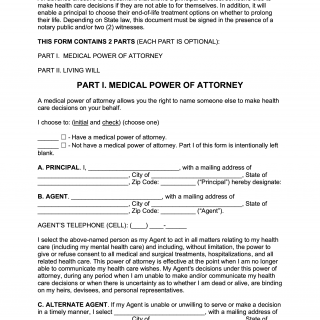Advance Directive Form
An Advance Directive form is a legal document that specifies an individual's healthcare preferences and instructions for medical treatment in the event that they are unable to make decisions for themselves. The main purpose of the form is to ensure that the individual's wishes are respected and that medical professionals understand their healthcare preferences.
The Advance Directive form typically consists of several parts, including the individual's personal information (such as name, address, and date of birth), the type of treatment they would like to receive or not receive, and the signature of the individual and a witness. The form may also include information about the individual's medical condition, as well as any specific instructions or limitations regarding medical treatment.
Important fields to consider when writing an Advance Directive form include the individual's name and address, the date the form was signed, the signature of the individual and a witness, and any specific instructions or limitations regarding medical treatment. It is important to attach any relevant documents to the Advance Directive form, such as a living will or a Do Not Resuscitate (DNR) form.
Examples of when an Advance Directive form may be necessary include when an individual wants to express their healthcare preferences in advance of a medical emergency, when an individual has a chronic medical condition that could result in their inability to make medical decisions, or when an individual wants to ensure that their healthcare preferences are respected in the event that they are unable to communicate them.
Strengths of the Advance Directive form include its ability to ensure that the individual's wishes are respected and that medical professionals understand their healthcare preferences. Weaknesses may include the potential for misunderstandings or disputes between family members and medical professionals. Opportunities include the ability to have open and honest discussions with loved ones and medical professionals about end-of-life care. Threats may include legal repercussions or financial penalties if the Advance Directive form is not properly completed or if medical professionals do not follow the individual's wishes.
Alternative forms or analogues to the Advance Directive form may include a living will or a DNR form. However, these forms may not provide the same level of specificity regarding medical treatment as an Advance Directive form. Differences between the Advance Directive form and other forms of advance care planning may include the level of formality, the clarity of the message, and the ability to provide a record of communication.
The Advance Directive form can have a significant impact on the future of the individual and their loved ones. For the individual, it can mean the ability to make decisions about their healthcare preferences and to ensure that their wishes are respected. For loved ones, it can mean having a clear understanding of the individual's desires and being able to provide support during a difficult time. The form should be submitted to the individual's healthcare provider, and a copy should be kept in the individual's medical records.
In summary, an Advance Directive form is a legal document that specifies an individual's healthcare preferences and instructions for medical treatment in the event that they are unable to make decisions for themselves. It is important to consider important fields and attach relevant documents when writing the form, as well as to have open and honest discussions with loved ones and medical professionals about end-of-life care. The form should be submitted to the individual's healthcare provider and a copy should be kept in the individual's medical records for future reference.

